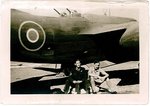Sydhuey
Airman
G'day All,
trying to find colours and markings for this Boston , it was flown by one of the guy's I work with's Uncle they crashed and crew all died while on a night shipping reccon/Interdiction sortie in Italy 02 Aug 1944, have writen to 18 Sqn association several times with no responce, we want to do an art profile of this aircraft and I will do a model of it , the pilots brother is still alive and was also an ex RAAF pilot in the Pacific (turns 90 at easter), HK 971 was a late delivery Boston III to the RAF taken on charge in Aug/Sep 43 taken from Russian allocated Bostons (HK serials were all this batch approx 60 a/c), I am asuming it would be in Dark Green and Dark Earth over Sky Grey , and pics of 18Sqn Boston IV's i've seen have had there code letter on the fin in Yellow, can't find any pics of 18 Sqn Boston III's several I have found marked as 18 Sqn turned out to be 107,88 and 24 SAAF , all help greatly appreciated Syd!
trying to find colours and markings for this Boston , it was flown by one of the guy's I work with's Uncle they crashed and crew all died while on a night shipping reccon/Interdiction sortie in Italy 02 Aug 1944, have writen to 18 Sqn association several times with no responce, we want to do an art profile of this aircraft and I will do a model of it , the pilots brother is still alive and was also an ex RAAF pilot in the Pacific (turns 90 at easter), HK 971 was a late delivery Boston III to the RAF taken on charge in Aug/Sep 43 taken from Russian allocated Bostons (HK serials were all this batch approx 60 a/c), I am asuming it would be in Dark Green and Dark Earth over Sky Grey , and pics of 18Sqn Boston IV's i've seen have had there code letter on the fin in Yellow, can't find any pics of 18 Sqn Boston III's several I have found marked as 18 Sqn turned out to be 107,88 and 24 SAAF , all help greatly appreciated Syd!


